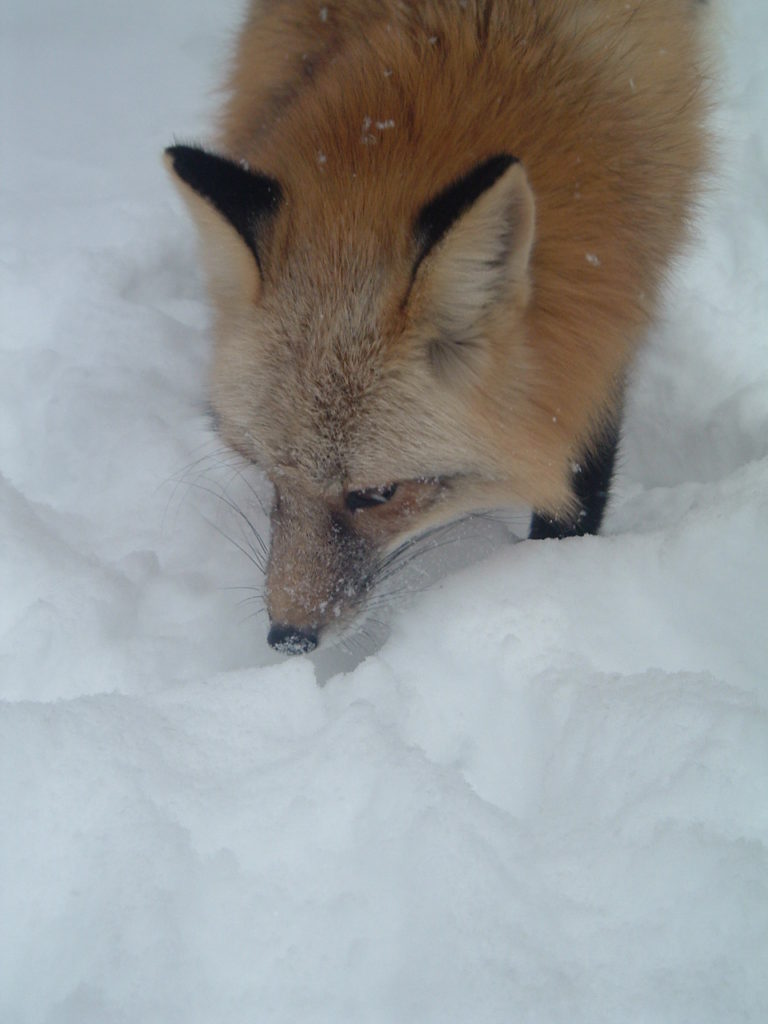Category: Grey Foxes
Gray Fox!
Many people never get the chance to see the elusive Gray fox. This is mostly because they are more nocturnal and deep woods than the more commonly seen Red fox. Grays tend to be more secretive, hanging out more in the areas where raccoons are than in the open fields. Unlike Red foxes, Grays can climb trees. In fact ,grays share a lot of characteristics in common with raccoons. They are very susceptible to Distemper, so much so that simply using the wrong Distemper vaccine can cause a gray fox to come down with the disease. Even with great care, Distemper is not a disease they are likely to survive. Like raccoons, a rabid Gray fox can be quite aggressive and rabid gray foxes are often misidentified as Red foxes. This is probably because of the rust coloration around their ears and neck. It is my belief that when the Health Department lists the rabid animals throughout our state that they should not be lumping Red and Gray foxes into one “fox” category- Reds and Grays are two completely different animals. Photo of “Baby Fox” courtesy of photographer Robert Watroba
Congenital Hydrocephalus in Red and Grey Fox Pups
 Congenital Hydrocephalus Hydrocephalus is an accumulation of Cerebrospinal Fluid (CSF) within the cavities (ventricles) of the brain. Hydrocephalus has been reported in most species of domestic animals and is one of the more common congenital malformations of the canine nervous system. In a recent study, small toy breeds with large skulls (i.e. Maltese, Pomeranian, Chihuahua, Toy poodle) and the brachiocephalic breeds (Boston terrier, Pekinese, English bulldog) were identified as being at high risk. The smaller the adult dog (whether dwarf or miniature in size) the higher the risk of hydrocephalus.
Congenital Hydrocephalus Hydrocephalus is an accumulation of Cerebrospinal Fluid (CSF) within the cavities (ventricles) of the brain. Hydrocephalus has been reported in most species of domestic animals and is one of the more common congenital malformations of the canine nervous system. In a recent study, small toy breeds with large skulls (i.e. Maltese, Pomeranian, Chihuahua, Toy poodle) and the brachiocephalic breeds (Boston terrier, Pekinese, English bulldog) were identified as being at high risk. The smaller the adult dog (whether dwarf or miniature in size) the higher the risk of hydrocephalus.
Viral transmission in utero is suspected to be a potential cause in the red fox. Diagnosis of hydrocephalus is based on clinical signs and is confirmed by radiographic demonstration of enlarged lateral ventricles by ventriculography. Plain radiography will often reveal a ground glass appearance throughout the cranial vault. Unfortunately, anesthesia is contraindicated in animals with suspected hydrocephalus. Cranial sutures and/or open fontanels may be evident after normal age for closure and skull ossification. Prognosis is poor. Treatment of animals with congenital hydrocephalus is futile because of the large amount of tissue destruction and atrophy. Shunting is risky and cost-prohibitive. Dexamethasone (0.25mg/kg PO q12h) may be used to temporarily relieve symptoms (not as a treatment. This is thought to primarily affect brain bulk and CSF production, not CSF absorption. USE FLUID THERAPY WITH CAUTION- DO NOT OVERHYDRATE A HYDROCEPHALIC PUP.
Common Intake Scenario: Pup found in an open area with no others around Often in the morning, sometimes after a rain- presumably because momma didn’t want to be trailed? Pup appears to have been left behind Often not near any roads it could have been hit on- though it can be mistaken as hit by car if found by the road. No visible injuries or illness, though they sometimes have Sarcoptic mange Fox pup acts very friendly and either very docile or very excitable May have even run up to people “out of the blue”
Two Age Groups and Scenarios:
 Age Group 1: 3-5 weeks old “fat and fuzzy stage” All the hydrocephalic pups this age that I have gotten in had the very obvious dome shaped skull The base of the skull was very large and wide. They eyes protrude and appear to have bags under them. Visual impairments including blindness, non-reactive pupils. The eyes may remain a bluish color Often the pup can not seem to lift its head and acts as though it has a severe headache. Inappropriate vocalizations (sick puppy cry or cerebral cry) Behavior and condition may come and go. One moment the pup seems down and out, and a half-hour later it is up and around and acting normal, barking for its mother. Be careful not to set a pup that appears immobile on a counter top or in a cardboard box that is not tightly closed – they can suddenly come around and end up taking a dangerous fall The symptoms may be temporarily relieved with a dose of Dexamethosone. Careful examination by a veterinarian may reveal that the fontanels are soft. Soft spots remain at skull sutures or junctions. The swelling in the brain prevents the fontanels from coming together. Hydrocephalus is extremely painful for the animal. The animal is suffering, will continue to suffer and should be euthanized as soon as possible, preferably by injection by a veterinarian.
Age Group 1: 3-5 weeks old “fat and fuzzy stage” All the hydrocephalic pups this age that I have gotten in had the very obvious dome shaped skull The base of the skull was very large and wide. They eyes protrude and appear to have bags under them. Visual impairments including blindness, non-reactive pupils. The eyes may remain a bluish color Often the pup can not seem to lift its head and acts as though it has a severe headache. Inappropriate vocalizations (sick puppy cry or cerebral cry) Behavior and condition may come and go. One moment the pup seems down and out, and a half-hour later it is up and around and acting normal, barking for its mother. Be careful not to set a pup that appears immobile on a counter top or in a cardboard box that is not tightly closed – they can suddenly come around and end up taking a dangerous fall The symptoms may be temporarily relieved with a dose of Dexamethosone. Careful examination by a veterinarian may reveal that the fontanels are soft. Soft spots remain at skull sutures or junctions. The swelling in the brain prevents the fontanels from coming together. Hydrocephalus is extremely painful for the animal. The animal is suffering, will continue to suffer and should be euthanized as soon as possible, preferably by injection by a veterinarian.
 Age Group 2: 6-16 weeks old These animals are often mistaken for being tame. Often they have been in captivity for a few weeks before being turned over to a rehabilitator. The people may say that they found the pup in their front yard or that it ran up to them. In the past I have considered that inadequate diet may be causing the odd symptoms, but after careful observation and the time to correct the diet have found this not to be the case. Pups that are older like this are generally showing more of the behavioral than the physical symptoms. The symptoms will come and go. The dome-shaped skull may not be obvious or even present. The pup may have a completely normal skull with no obvious doming.
Age Group 2: 6-16 weeks old These animals are often mistaken for being tame. Often they have been in captivity for a few weeks before being turned over to a rehabilitator. The people may say that they found the pup in their front yard or that it ran up to them. In the past I have considered that inadequate diet may be causing the odd symptoms, but after careful observation and the time to correct the diet have found this not to be the case. Pups that are older like this are generally showing more of the behavioral than the physical symptoms. The symptoms will come and go. The dome-shaped skull may not be obvious or even present. The pup may have a completely normal skull with no obvious doming.
Behavioral symptoms may include: Difficulty with sense coordination i.e. can smell the food but can’t seem to find it even when it is right under their nose. It will hear a noise, but not be able to determine from which direction it is coming from Hyperactivity Eyes may appear to have bags under them Excessive panting or respiration rate Unusually intense vocalization “banshee scream” Unusually deep sleeps – you could partially pick up the animal before it wakes. Sounds that would cause a normal fox to wake and lift its head from sleep will not awaken a hydrocephalic pup. This condition comes and goes. The fox runs in circles instead of straight lines. The circling is often in just one direction. Hyperextension of one or both forelegs when moving. This is often noticed during circling. The leg may actually reach as high as to scrape the ear. Unusual intensity of tail wagging and vocalization when excited. Self-mutilation, biting of the tail Inability to see Weakness, easily fatigued Respiratory distress Frequent pacing, circling, gait abnormalities Hind leg paralysis Hypersensitivity to loud sudden noises Sitting with head tilted down as though with a severe headache Seizures after a meal.
Please note that unless you are observing the animal 24 hours a day it may be having seizures without your knowledge. Often a seizure is followed by death. A visit to the vet for a sonogram or radiography and or careful observation over the course of a few days, or even longer may be needed to diagnose hydrocephalus. The condition comes and goes and the symptoms change. This makes euthanasia a very difficult decision to make. Especially when you are observing an animal that may appear cosmetically perfect with no broken limbs, obvious defects. Pressure on the brain is a very painful condition and an animal that is hydrocephalic is suffering. It can not be cured. I have tried holistic methods as well as steroid therapy, also time to try to allow growth. None of these treatments work. If you are a wildlife rehabilitator and you have a fox pup that you need help with, please contact me.






